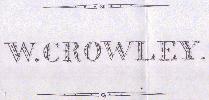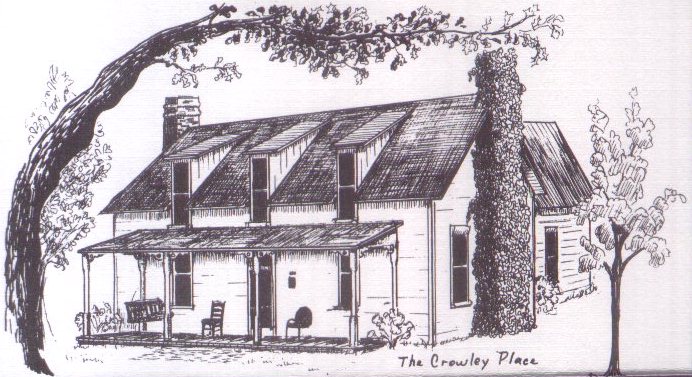|
- IN ENGLAND
Born in Middlesex (London), England, in 1806.
This is based on his own statement on his second army enlistment
(see below).
- IN THE U.S.
Came to the United States prior to or early in 1836. We have no
documentation of the date. Enlisted in the U.S. Army for the first
time on May 9, 1836, at Utica, New York. (Utica is on the Erie Canal,
which opened in 1825.) He gave his occupation as "clerk," and gave
his age as 30. His signature showed excellent penmanship.
The enlistment certificate states that he had hazel eyes, brown hair,
florid complexion, and was 5 feet 10 and 1/4 inches high (Appendix C).
He was recruited by H. Day, 1st lieutenant, 2nd Infantry. The 2nd
Infantry was under the command of General Zachary Taylor in the
Second Seminole War. Zachary Taylor's biography states:
"General Order No. 7, issued April 10 (1838) . . . assigned . . .
six companies of the 2nd Infantry [to Florida]." This must have
included Private William Crowley. From the U.S. Archives we got a
copy of the "Descriptive and Historical Register" document that
showed William was discharged at Fort Macomb, Florida, on May 9, 1839,
on the expiration of his original enlistment. His discharge was from
the 2nd Infantry, Company "K." The ink is very dim, but his rank
appears to be "sergeant." There may have been more than one fort by
that name, but one Fort Macomb that seems likely was on the west side
of the Suwannee River near Dowling Park in present-day Lafayette County.
At the National Archives Southwest Region, Fort Worth, we found
information on Microfilm M-661, Roll 5, Historical Information Relating
to Miliary Posts and Other Installations, ca. 1700- 1900. Nearly all
the information is handwritten; on page 5 we found this description:
"Fort Macomb, Florida. Suwanee (sic) river. Lat. 30.02, Long. 83.15.
Named after Genl. Alxr. Macomb, USA. On the Suwannee river, about 3 miles
below the foot of the rapids in Lafayette county. Established April 16,
1839. Abandoned Feb. 5, 1843."
William re-enlisted in the U.S. Army at "Fort No. 15" on June 23, 1840.
Microfilm M-661, Roll 5, page 404, has information about four of these
numbered forts: 17, 16, 4, and 11, but, unfortunately, not No. 15.
Zachary Taylor, commanding the army against the Seminoles, divided the
disputed areas of Florida into 20-mile squares, and established a "fort"
in each square staffed by 20 men (half of them mounted), and one officer.
We think "Fort No. 15" represented one of these squares, although it was
more of a triangle, as it was bounded on the west by the Gulf of Mexico.
The small town of Steinhatchee is at about the center of the "square,"
on a navigable tidal creek.
A mystery: William's first tour of duty ended on May 9, 1839, and he
re-enlisted on June 23, 1840, more than a year later. Where was he that
year? Did he remain in Florida as a civilian? Or did he return to his
family (a wife and baby girl) in New York, then go back to Florida to
re-enlist with his buddies in the 2nd Infantry?
About 1836 or 1837 we figure, William had married Mary, who probably was
born in 1816 or thereabouts. Family tradition says that she was a
McGregor, but we have no documentation of her maiden name. The place
of marriage is also unknown. Circumstantial evidence indicates that
they were married in New York State, but there's no proof. Their first
child, Roseanna, was born in the U.S. in 1838. Thomas, their first son,
was also born in the U.S., about 1842. The other two children, James
and Mary, were born in Canada, in 1845 and 1847.
William was discharged at the expiration of his second enlistment in the
U.S. Army on June 23, 1845, at Buffalo Barracks, New York, in the
City of Buffalo.
- IN CANADA
On June 6, 1845, 17 days before his U.S. Army discharge, he signed a
"lease to buy" a 100-acre farm in the Fullarton Township of Perth County,
from the Canada Company, a land-settlement company based in London,
England. Buffalo Barracks was being closed down at the time, so he may
have been allowed to leave early--or perhaps he had unused leave.
By the time of the 1847 Canadian census, Mary Crowley was head of the
household, and later documents list her as "widow." From this, and from
family tradition, we believe that William Crowley died in 1847.
"The Illustrated London News."
Copies of "The Illustrated London News,"
originally sent to Pvt. Crowley at the Buffalo Barracks,
have greciously been donated to the Theodore Roosevelt National Historic Site
by Mr. & Mrs. Claude Crowley of Ft. Worth, Texas, and
are available for all to see upon request.
 
Wm Crowley care of Capt. S. Casey "C" Company 2nd Infantry Buffalo Barracks Lake Erie United States
Courtesy of Carolyn & Claude Crowley of Ft. Worth, TX

William Crowley's nameplate;
from "The VISITOR, for 1842."
A monthly religious instructor from London.

Some of William's descendants grew up in this house in Cookeville, TN.
Drawing by Claude Crowley
|